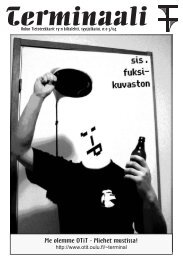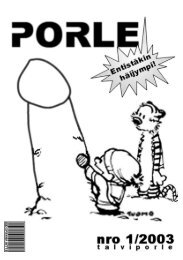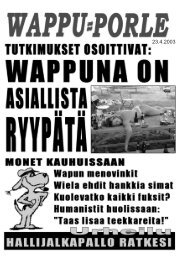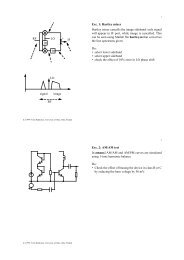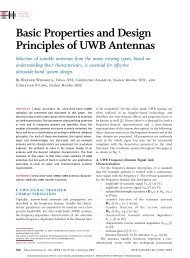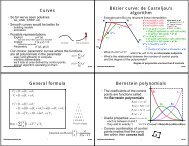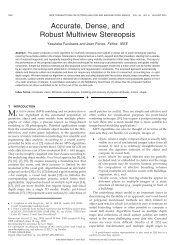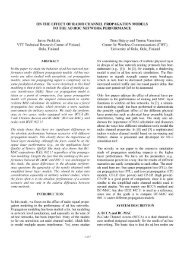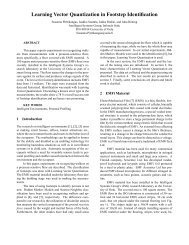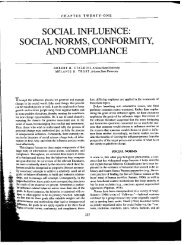Animation Ways to animate Keyframing What can you keyframe?
Animation Ways to animate Keyframing What can you keyframe?
Animation Ways to animate Keyframing What can you keyframe?
You also want an ePaper? Increase the reach of your titles
YUMPU automatically turns print PDFs into web optimized ePapers that Google loves.
Skinning<br />
• If <strong>you</strong> just attach rigid geometry <strong>to</strong> bones, they don’t<br />
behave naturally at the seams<br />
• they look very stiff, like a robot<br />
• between segments <strong>you</strong> <strong>can</strong> see cracks instead of<br />
continuous joints<br />
• with the robot, we dealt with that by hiding joints with cylinders<br />
• Solution<br />
• associate a vertex with several bones<br />
• weight each association<br />
• when transforming bones, apply a weighted<br />
combination of the transforms <strong>to</strong> each vertex<br />
• In Blender this is done by<br />
• assigning vertex groups <strong>to</strong> bones,<br />
http://blenderchar.weirdhat.com/handtute/<br />
• painting a vertex weight, http://mmaigrot.free.fr/didac-blender/ikas/ikas-eng/ikp5.php<br />
52438S Computer Graphics Winter 2004 21<br />
Kari Pulli<br />
Particle systems<br />
• Use particle systems <strong>to</strong> model various natural phenomena<br />
• dynamic:<br />
• fire, explosions (flames, sparks)<br />
• smoke (soot)<br />
• rain, snow (rain drops, snow flakes)<br />
• static<br />
• grass<br />
• fur<br />
• Properties of particles<br />
• they are created, grow in age, may breed, get old and die<br />
• their colors and shapes may evolve<br />
• they <strong>can</strong> be affected by forces (wind, gravity, …)<br />
• Flocking behavior<br />
• if <strong>you</strong> add an AI component, <strong>you</strong> <strong>can</strong> model the behavior of flock of<br />
birds, school of fish, pack of dinosaurs, …<br />
• widely used in movies (Jurassic Park, Quasimodo, …)<br />
52438S Computer Graphics Winter 2004 23<br />
Kari Pulli<br />
Dynamics<br />
• Definitions:<br />
• Kinematics: how the positions of the parts vary as a<br />
function of the joint angles<br />
• Dynamics: how the positions of the parts vary as a<br />
function of applied forces<br />
• Requires real physics simulation<br />
• Forward dynamics<br />
• integrate the effects of the forces as a function of time<br />
• Inverse dynamics<br />
• given the desired path / behavior, which forces are needed?<br />
• This is already rocket science<br />
• control theory<br />
52438S Computer Graphics Winter 2004 22<br />
Kari Pulli<br />
Particles in Blender<br />
• Create a plane<br />
• Go <strong>to</strong> Anim But<strong>to</strong>ns (F7)<br />
• New Effect, change Build <strong>to</strong><br />
Particles<br />
• Norm = 0.100 <strong>to</strong> emit<br />
particles with initial speed<br />
along plane normals<br />
• Rand = 0.100 <strong>to</strong> add<br />
randomness<br />
• Force Z = -0.070 <strong>to</strong> add gravity<br />
Randomness<br />
of particle age<br />
Total number<br />
of particles<br />
Particle generation<br />
start & end (frames)<br />
Duration of<br />
particles &<br />
their children<br />
Damping<br />
works like<br />
friction<br />
52438S Computer Graphics Winter 2004 24<br />
Kari Pulli




